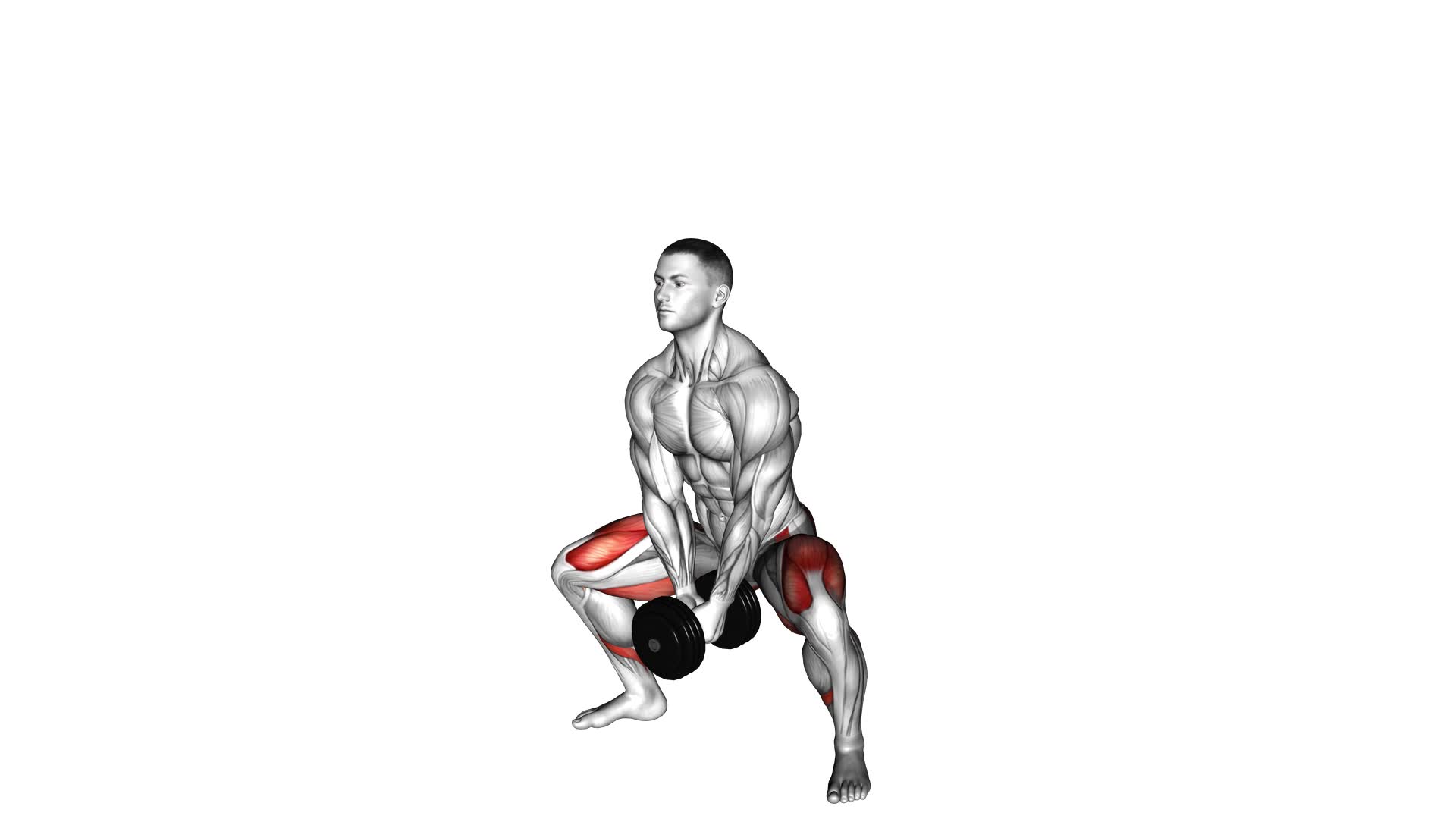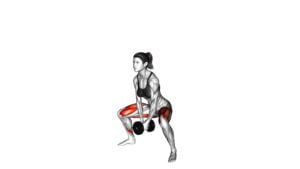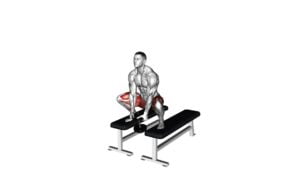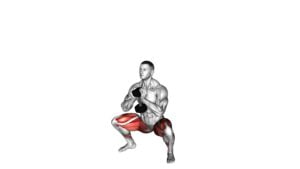Dumbbell Bar Grip Sumo Squat (male) – Video Exercise Guide & Tips

Get ready to take your squat game to the next level with the Dumbbell Bar Grip Sumo Squat. This exercise targets your lower body, helping you build strength and power.
Watch This Exercise Video
In this video exercise guide, we'll show you the proper form and technique, as well as variations to challenge yourself. Avoid common mistakes and follow our tips for optimal results.
Let's get started and make those gains!
Key Takeaways
- Targets multiple muscle groups in the lower body
- Engages the quadriceps, hamstrings, and glutes
- Strengthens and tones the inner thighs
- Builds strength and stability
Benefits of Dumbbell Bar Grip Sumo Squat
By incorporating the dumbbell bar grip sumo squat into your workout routine, you can effectively target multiple muscle groups while improving your lower body strength and stability.
The dumbbell bar grip sumo squat is a modified version of the traditional sumo squat, which involves holding a dumbbell bar with an overhand grip instead of using dumbbells or a barbell. This modification adds an extra challenge to the exercise by increasing the weight and placing more emphasis on the muscles of the lower body.
When performing the dumbbell bar grip sumo squat, you primarily work the muscles of the legs, including the quadriceps, hamstrings, and glutes. The wide stance and sumo squat position engage the inner thighs, helping to strengthen and tone this often-neglected muscle group. Additionally, the exercise also engages the core muscles, as they're responsible for maintaining stability throughout the movement.
To modify the dumbbell bar grip sumo squat, you can adjust the weight of the dumbbell bar based on your fitness level and goals. You can increase or decrease the weight to make the exercise more challenging or more accessible. Additionally, you can also experiment with different foot positions and angles to target specific muscle groups or add variation to your workout routine.
Proper Form and Technique
Stand with your feet shoulder-width apart and hold the dumbbell bar with an overhand grip, positioning it in front of your body.
To perform the Dumbbell Bar Grip Sumo Squat with proper form and technique, it's important to understand the key elements. Firstly, make sure your back is straight and your core is engaged throughout the exercise. This will help maintain stability and prevent injury.
As you lower into the squat, focus on pushing your hips back and bending your knees. Keep your weight on your heels and aim to lower your hips until they're parallel to the ground. Remember to maintain control and avoid bouncing at the bottom of the movement. As you stand back up, push through your heels and squeeze your glutes at the top.
It is important to note that the Dumbbell Bar Grip Sumo Squat is an effective warm-up exercise for your lower body, as it targets multiple muscle groups including the quadriceps, hamstrings, and glutes. It can also help improve hip mobility and strengthen the core.
Now that you understand the proper form and technique, let's move on to the next section where we'll discuss variations to increase difficulty and maximize your workout.
Variations to Increase Difficulty
To increase the difficulty of the Dumbbell Bar Grip Sumo Squat, there are several variations you can try.
First, you can add more weight to the dumbbell bar to challenge your muscles even further.
Additionally, changing your foot positioning, such as widening your stance or turning your toes out, can engage different muscle groups and intensify the exercise.
Lastly, incorporating plyometric movements, like adding a jump or explosive movement at the top of the squat, can increase the overall difficulty and enhance power and explosiveness.
Adding More Weight
To increase the difficulty of the Dumbbell Bar Grip Sumo Squat exercise, you can add more weight. Adding more weight is an effective way to increase resistance and challenge your muscles further. By increasing the resistance, you'll engage more muscle fibers and promote greater strength gains.
To perform this advanced modification, simply grab heavier dumbbells or add weight plates to the barbell. Make sure to maintain proper form and control throughout the exercise to prevent injury. As you become stronger and more comfortable with the added weight, you can gradually increase the load to continue challenging your muscles. Adding more weight will push your body to adapt and grow stronger.
Now, let's explore another way to intensify the Dumbbell Bar Grip Sumo Squat exercise by changing foot positioning.
Changing Foot Positioning
To increase the difficulty of the Dumbbell Bar Grip Sumo Squat exercise, you can change your foot positioning. By modifying your foot placement, you can target different muscles and challenge your balance and stability.
One common modification is to widen your stance, placing your feet wider than shoulder-width apart. This variation increases the activation of your glutes and inner thighs.
Another option is to turn your toes outward, known as the duck stance. This targets your adductors and emphasizes the inner thighs. However, be cautious of common mistakes in foot placement, such as placing your feet too close together or turning your toes too far outward, as this can put unnecessary strain on your knees.
Now, let's explore incorporating plyometric movements to further intensify your workout.
Incorporating Plyometric Movements
To increase the difficulty and intensity of your Dumbbell Bar Grip Sumo Squat exercise, incorporate plyometric movements that challenge your muscles and elevate your heart rate. Plyometric training involves explosive movements that require rapid muscle contractions, resulting in increased power and strength.
One way to incorporate plyometrics into your sumo squat is by adding a jump at the top of the movement. As you rise from the squat position, explode off the ground, extending your hips and knees while lifting your feet off the floor. Land softly back into the squat position and repeat. This variation not only enhances the effectiveness of the exercise but also adds a cardiovascular component to your workout.
By incorporating plyometric movements into your dumbbell bar grip sumo squats, you'll take your training to the next level.
Now, let's discuss some common mistakes to avoid.
Common Mistakes to Avoid
One common mistake to avoid when performing the Dumbbell Bar Grip Sumo Squat isn't maintaining proper form throughout the exercise. This can lead to a variety of issues, including ineffective muscle engagement and potential injuries. To avoid these problems, it's crucial to understand the correct technique and make necessary modifications for beginners.
Firstly, it's important to maintain a wide stance with your feet slightly turned out, ensuring that your knees track in line with your toes. This will help to engage the glutes, hamstrings, and quadriceps effectively. Additionally, keep your chest up and core engaged throughout the movement to maintain stability and prevent excessive forward leaning.
Another common mistake isn't using an appropriate weight for your fitness level. Beginners should start with lighter dumbbells to focus on proper form and gradually increase the weight as they become more comfortable and confident in their technique.
Furthermore, it's essential to avoid rounding your back during the exercise. This can place unnecessary strain on the spine and increase the risk of injury. Instead, focus on maintaining a neutral spine position and engaging your core muscles to provide stability and support.
Tips for Maximal Results
To achieve maximal results with the dumbbell bar grip sumo squat, it's crucial to focus on proper form. Maintaining a wide stance and keeping your chest up will engage the target muscles effectively.
Additionally, utilizing effective breathing techniques, such as exhaling during the upward movement, can enhance your performance.
Lastly, consistency in performing this exercise is key to making progress and seeing optimal results.
Proper Form Importance
Achieve maximal results by ensuring your form is correct during the Dumbbell Bar Grip Sumo Squat exercise. Proper form is crucial because it allows you to target the correct muscles and reduce the risk of injury.
One important aspect of form is flexibility. Many people overlook the importance of flexibility when performing squats, but it plays a key role in executing the exercise correctly. Flexibility in your hips, ankles, and hamstrings allows for a deeper squat and better engagement of the glutes and quads.
Additionally, there are common misconceptions about form during the Dumbbell Bar Grip Sumo Squat. Some mistakenly believe that leaning too far forward or allowing the knees to cave in is acceptable. However, these errors can compromise the effectiveness of the exercise and increase the risk of injury.
Effective Breathing Techniques
Breathe deeply and rhythmically to optimize your results during the Dumbbell Bar Grip Sumo Squat exercise. Proper breathing techniques play a crucial role in enhancing your performance and maximizing your gains. Incorporating specific breathing exercises and mindfulness techniques can help you achieve better focus, stability, and control during this exercise.
One effective breathing technique is diaphragmatic breathing, also known as belly breathing. To practice this technique, inhale deeply through your nose, allowing your belly to expand as you fill your lungs with air. Then, exhale slowly through your mouth, contracting your abdominal muscles to push out the air.
Another helpful technique is to synchronize your breath with your movements. Inhale as you lower yourself into the squat position, and exhale as you push up and return to the starting position. This rhythmic breathing pattern can help you maintain proper form and exert maximum effort.
Consistency for Progress
By maintaining consistent effort and dedication, you can make significant progress and achieve optimal results during the Dumbbell Bar Grip Sumo Squat exercise.
Consistency is key when it comes to maximizing gains and overcoming plateaus. Make sure to perform the exercise regularly, following a structured workout plan that includes the Dumbbell Bar Grip Sumo Squat.
Aim to gradually increase the weight and intensity of the exercise over time, challenging your muscles and pushing yourself to new limits. Additionally, focus on maintaining proper form and technique throughout the movement to ensure maximum effectiveness.
Consistency won't only help you see progress in your strength and muscle development but also prevent stagnation and plateaus.
Now, let's move on to a sample dumbbell bar grip sumo squat workout to put these tips into action.
Sample Dumbbell Bar Grip Sumo Squat Workout
To begin your Sample Dumbbell Bar Grip Sumo Squat workout, position your feet wider than shoulder-width apart. This wide stance allows for greater activation of the glutes, hamstrings, and quadriceps. Hold a dumbbell bar with an overhand grip, ensuring that your hands are shoulder-width apart. The dumbbell bar adds an extra challenge to the exercise, increasing the resistance and intensity.
As you lower into the squat, keep your chest up and your back straight. Engage your core muscles to maintain stability throughout the movement. Lower yourself until your thighs are parallel to the ground, or as close as you can comfortably go. Pause for a moment at the bottom of the squat, then push through your heels to return to the starting position.
For modifications, you can use lighter dumbbells if the weight is too challenging. Additionally, if you have limited mobility in your hips or knees, you can reduce the depth of the squat.
The benefits of the dumbbell bar grip sumo squat are numerous. It targets multiple lower body muscles, including the quadriceps, hamstrings, glutes, and calves. It also improves hip mobility and strengthens the core. By incorporating this exercise into your routine, you can increase lower body strength, improve overall stability, and enhance athletic performance.
Frequently Asked Questions
What Are the Benefits of Incorporating the Dumbbell Bar Grip Sumo Squat Into My Workout Routine?
Incorporating the dumbbell bar grip sumo squat into your workout routine offers several benefits. This exercise targets your lower body muscles, including your quadriceps, hamstrings, and glutes, helping to strengthen and tone them. The wide stance and sumo grip engage your inner thighs and add an extra challenge to the movement.
Additionally, this exercise improves your balance and stability. To perform it properly, maintain proper form and technique by keeping your back straight, knees in line with your toes, and lowering your hips until your thighs are parallel to the ground.
How Do I Properly Execute the Form and Technique of the Dumbbell Bar Grip Sumo Squat?
To properly execute the form and technique of the dumbbell bar grip sumo squat, you need to focus on a few key points.
First, position your feet wider than shoulder-width apart and point your toes outward.
Hold the dumbbell bar with an overhand grip and position it in front of your body.
As you squat down, keep your chest up, back straight, and knees tracking over your toes.
This exercise targets your lower body muscles and helps improve your strength and stability.
Are There Any Variations of the Dumbbell Bar Grip Sumo Squat That Can Increase the Difficulty?
To increase the difficulty of the dumbbell bar grip sumo squat, there are several variations and advanced techniques you can try. These include:
- Adding more weight to the dumbbells
- Increasing the range of motion by squatting lower
- Incorporating explosive jumps into the exercise
By challenging yourself with these variations, you can further engage your muscles, increase strength, and improve overall fitness.
Remember to always maintain proper form and technique when attempting these advanced techniques.
What Are Some Common Mistakes to Avoid When Performing the Dumbbell Bar Grip Sumo Squat?
When performing the dumbbell bar grip sumo squat, it's important to be aware of some common mistakes to avoid. Proper execution is key to maximize the benefits of this exercise.
Some common mistakes include not maintaining proper form, such as allowing your knees to cave inwards or leaning too far forward.
It's also important to avoid using weights that are too heavy, as this can lead to improper form and potential injury.
Do You Have Any Tips for Maximizing Results While Performing the Dumbbell Bar Grip Sumo Squat?
To maximize results while performing the dumbbell bar grip sumo squat, there are a few tips you should keep in mind.
First, focus on increasing the intensity by gradually increasing the weight and reps over time.
Second, make sure to maintain proper form throughout the exercise to target the desired muscles effectively.
Lastly, don't fall for common misconceptions about this exercise, such as using excessive weight or neglecting the full range of motion.
Conclusion
In conclusion, the dumbbell bar grip sumo squat is a highly effective exercise that targets multiple muscle groups, including the quads, hamstrings, and glutes.
By maintaining proper form and technique, individuals can maximize the benefits of this exercise and avoid common mistakes.
Incorporating variations and gradually increasing difficulty can further enhance the workout.
Following these tips and incorporating the dumbbell bar grip sumo squat into a well-rounded fitness routine can lead to significant gains in strength and muscle development.

Author
Years ago, the spark of my life’s passion ignited in my mind the moment I stepped into the local gym for the first time. The inaugural bead of perspiration, the initial endeavor, the very first surge of endorphins, and a sense of pride that washed over me post-workout marked the beginning of my deep-seated interest in strength sports, fitness, and sports nutrition. This very curiosity blossomed rapidly into a profound fascination, propelling me to earn a Master’s degree in Physical Education from the Academy of Physical Education in Krakow, followed by a Sports Manager diploma from the Jagiellonian University. My journey of growth led me to gain more specialized qualifications, such as being a certified personal trainer with a focus on sports dietetics, a lifeguard, and an instructor for wellness and corrective gymnastics. Theoretical knowledge paired seamlessly with practical experience, reinforcing my belief that the transformation of individuals under my guidance was also a reflection of my personal growth. This belief holds true even today. Each day, I strive to push the boundaries and explore new realms. These realms gently elevate me to greater heights. The unique combination of passion for my field and the continuous quest for growth fuels my drive to break new ground.







